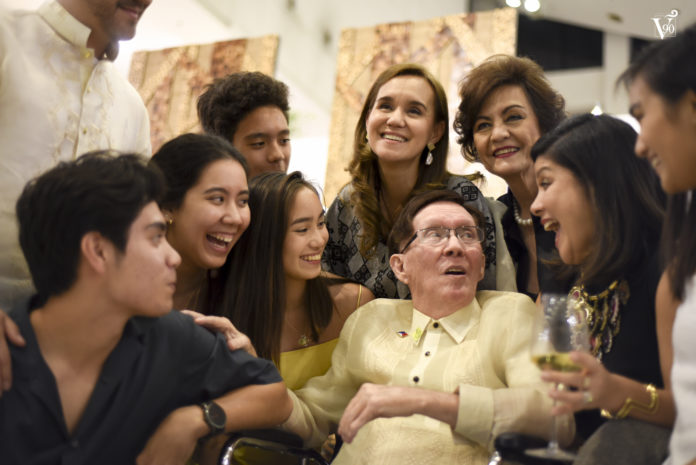RENOWED Thomasian architect Francisco “Bobby” Mañosa was named “National Artist” last Oct. 24.
Mañosa, a graduate of the old College of Architecture and Fine Arts in 1953, is known not only as a talented designer and architect but also as a pioneer in the field of Philippine architecture.
College of Architecture Dean Rodolfo Ventura hailed the National Artist for his efforts to establish a style of architecture that “is more or less Filipino in a way.”
“He deserves [it very] much as he was able to come up with a style of architecture that is more or less Filipino in a way, as compared to the others that are neutral, in his case he really fought for that. [H]e was consistent in his designs and very much professional talaga,” said Ventura in an interview with the Varsitarian.
He said architecture graduates of the University should follow his example of being nationalistic and firm in his beliefs.
“Being nationalistic in a way and being firm with his beliefs as far as his style is concerned, being consistent, that is something we should cherish. The Filipino style of architecture was more or less, he was able to capture a distinct character that makes it relevant to the Filipinos,” he added.
As a tribute, Ventura said the college is preparing life size portraits of Mañosa and Thomasian National Artists for Architecture such as Leandro Locsin, Idelfonso Santos and Jose Maria Zaragoza to be displayed at the Beato Angelico Building.
The attempt to catch the Philippine psyche and to make the Filipinos acknowledge and recognize the beauty of their own has been Mañosa’s goal. His personal style has eschewed foreign influence and encouraged Filipino architects to believe in one’s creativeness and to stop using alien cultures and designs.
Architect and historian Gerard Lico said Mañosa’s innovative use of indigenous materials has become his signature.
“He is in a constant search for new technologies and methodology to cast the status of indigenous building materials as a suitable material for contemporary construction and modern decoration,” Lico told the Varsitarian.
His father Manuel Mañosa, a former dean of the Faculty of Engineering, was the one who pushed him to take up architecture but his musical creativity still reflected in the playfulness of his designs and structures.
In his college days, he discovered his take on Filipino architecture, coming across a philosophy called “organic architecture” or the conceptualization of designs that were created in harmony with nature and physical conditions. From this discovery, he established his design philosophy of sustainability and versatility of organic and local materials.
In an interview with the Varsitarian back in 2010, Mañosa said architecture is not about the tedious imitation of others’ work, but about imagination and innovation.
“This process of creation must strive to express who we are and define our unique place in this world,” he said.
For more than 50 years, Mañosa has endorsed Philippine architecture after seeing that Filipinos have become more interested in the architecture of other countries.
“I was so touched by all the distinct architectures of the world that I convinced myself on pursuing this Filipino architecture. To do Filipino, I must know my country, and I have to believe in what my country can offier,” he added.
He is also known for injecting high ceilings, steep and sloping roofs, large windows and angular overhangs in his designs to accommodate the country’s tropical weather.
One example of this experiment was the Coconut Palace made of Philippine hardwood and coconut shells.
He once deviated from his typical architectural works and created playscape designs and Filipino-inspired toys such as the seasoned carnival Bigbang sa Alabang in Muntinlupa and Bobi trucks and tipaklong.
His other works are the San Miguel Building in Ortigas, the Shrine of Mary in Epifanio de los Santos Avenue (EDSA), the St. Joseph Church in Las Piñas and the San Lorenzo Ruiz Monument in Manila.
In 2009, he was proclaimed a National Artist by former president Gloria Macapagal-Arroyo, but in 2013, he, along with four other recipients, was stripped of the title by the Supreme Court.
Ma. Rebecca Peñafiel, an associate professor of the College of Architecture, emphasized the influence of Mañosa on Filipino architects such as herself.
“Every time we design a building we think about reflecting our culture in the use of spaces, about providing cross ventilation, ensuring enough sunlight reaches the interiors, [and so on],” Peñafiel said. “This is because this is what he taught us.”
Last year, the UST’s Heritage Conservation Society-Youth Chapter organized “Visionary Comes Home: A Mañosa Beyond Architecture,” an exhibit solely dedicated to Mañosa’s work.
Mañosa received numerous awards and recognitions including the Knighthood of the Pontifical Order of St. Gregory in 1979, the Golden Award in the field of Architecture from the United Architects of the Philippines in 1989 and the Cultural Center of the Philippine’s (CCP) Award for the Arts in the field of Architecture in 2004.
The National Artists Award is the highest recognition given to an individual who has exhibited significant contributions to the Philippine art scene. Inducted in 1972, this award is a joint recognition by the CCP and the National Commission for Culture and the Arts (NCCA).














